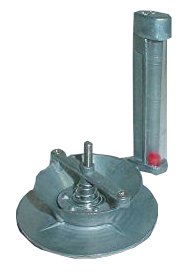Thanks Blackwater . . . It's definitely worth a try. And your point on linkage is well taken - mine is solid - any setting enforced by a stop screw on one carb will be equally transmitted to the other.
And then there's panic's approach:
Dress the fast idle cam lobe down the same amount on both.
to try to get both fast idle cams to work in concert.
I will give both options a try and report back.
For now here is where things stand. I have removed the linkage between the two carbs completely in order to prepare for using a sync tool to verify idle balance:

Once if have base timing and idle balance I can experiment with both fast idle options.
Which takes me back to the teeter-totter I mentioned earlier.
The engine is now under control and idling solely on the idle circuits. I can moderate engine RPM with both the throttle set screws and idle metering screws. If my Sun Tach is calibrated correctly (unknown) idle is controllable between ~900 and ~1200 RPM.
The engine seems to prefer 5 to 7 degrees BTDC of initial timing - beyond 7 it is hard to start when fully warmed up. At higher initial advance the engine doesn't seem to want to be throttled. It pops and raps the exhaust pipes and eventually stalls. But throttle response is good.
Backing initial timing down to 2 degrees BTDC or even TDC allows me to tune for a lower idle RPM ~900. But it is a rough and stinky idle and the throttle response tends to hesitate if not bog.
Vacuum signal is definitely at play here. Above 1000 RPM the vacuum gauge is steady at 16" and the main metering rods remain bottomed out - allowing the idle metering screws to dictate mixture. Below 1000 RPM the the vacuum gauge starts to bounce between 10" and 15" - this in turn causes the metering rods to bounce.
Every time the metering rods come off their seats they enrich the mixture beyond the setting of the idle mixture screws. Hence the stinky exhaust.
Going to sleep on the problem . . .

